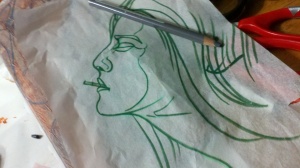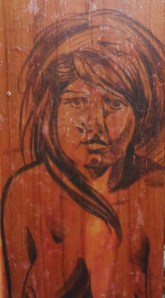Gel medium to transfer drawings and sketches, DIY
 So I got a huge tub of soft gel medium, and immediately decided I wanted to put some of the drawings I’ve been doing (mostly figure studies) onto some cedar planks I had. I searched for a how-to, and could only find people discussing photocopies, printed photos.
So I got a huge tub of soft gel medium, and immediately decided I wanted to put some of the drawings I’ve been doing (mostly figure studies) onto some cedar planks I had. I searched for a how-to, and could only find people discussing photocopies, printed photos.
Nobody seemed to be interested in putting their own drawings onto other surfaces- or if they were, they were willing to photocopy them first.
I wasn’t interested in that- I wanted to draw the piece on paper myself, in reverse, and then transfer it right to the wood.
I read up about the way gel medium works. If you’re using something that soaks into the paper, it won’t transfer. You need to be using something that sits on the surface of the paper, like prismas on tracing paper, or like inks on copy paper, or dry paints.
I used:
- a roll of thin, cheap tracing paper
- prismacolor pencils
- cedar planks, pretty smooth thin planks cut to size
- golden soft gel medium
- a soft brush
- water, a dishrag, and elbow grease
- patience
- gouache and FW liquid acrylic inks
First, I drew. I sketched a few things out- using the prismacolors in heavy layers on the tracing paper.
I really pressed down- I’m used to using these with a very heavy hand, so this wasn’t out of the ordinary.
You need a good solid layer of the pencils, for the transfer to work properly.
And of course, I sketched it out on one side of the paper, then flipped it and drew on the reverse. When you make the transfer everything will be a mirror image, so you want the drawing to be backwards.
 Once you have your drawing (I did several in just linework/sketch style, and several in full shadow and light)
Once you have your drawing (I did several in just linework/sketch style, and several in full shadow and light)
Then you want to prep your wood.
Get a layer of gel medium on the wood. If you use a bit of water and make a thinner layer, you will lose more of the image when you wipe it down later- If your coat is too thick it’ll buckle the paper oddly and take FOREVER to dry. So go for an in-between, a nice even layer, not too heavy. Since the gel medium is white when it’s wet, go for about a 50% translucency with it, and you’ll have about the right amount.
Immediately flip your drawing onto the wood surface you just put that glaze on.
 Using your fingers, the heels of your hand, press from the center outward on the paper, and try to get any bubbles out to the edge and off the surface. Bubbles will make for areas without the transfer.
Using your fingers, the heels of your hand, press from the center outward on the paper, and try to get any bubbles out to the edge and off the surface. Bubbles will make for areas without the transfer.
Now, go do something else. Seriously. You want to forget about these and let them dry ALL THE WAY THROUGH, at least three hours- more if you can manage any patience at all.
The longer you wait, the better the transfer will adhere to the surface.
The less a pain in the ass the next step will be.
No seriously-
Three hours.
Go fucking eat.
Something.
Do something, sleep, watch two movies. I made more transfers. I did more drawings and laid em out assembly line style- then I took a bath. And then I watched Godzilla 1998, which sucked because DUH matthew broderick, if it’s pregnant IT’S FEMALE, parthenogenesis only happens to FEMALE ANIMALS, what a fucking let down too, and the sequel tie-in sucked.
Ok now that they have dried totally (TWO movies), there should be no milky white left, just clear glaze. I am using matte medium, so it isn’t shiny once it dries either.
Get some water and a dishrag, and soak the paper your drawing was on. Just soak it. Then rub off, destroy the paper itself, wipe and rub it off of the wood. That sounds suggestive but there’s no other way to describe how to do it.
Get it wet, and then rub it off the wood.
Let it dry again- just for a little while this time-
Then double check. White parts mean you left some paper on there- keep rubbing with water until all the paper is gone.
 Don’t SCRUB, not too hard- because you can also scrub off the medium, depending on how smooth the surface is that you’re transferring to. I found that smoother wood made less trouble this way.
Don’t SCRUB, not too hard- because you can also scrub off the medium, depending on how smooth the surface is that you’re transferring to. I found that smoother wood made less trouble this way.
Once all the paper is rubbed away, you’ll have a transfer on the surface.
It will have small inconsistencies.
It may need a second go at removing paper bits.
It should be exactly what you put there.
If you want it to look best,
Try to use dark colors as the foreground, and light colors or nothing as the background. The edge of the paper will show if you have a dark background, and will make the subject harder to discern.
I am sure there may be some uses for that but for what I was trying to do it wasn’t working.
This is the basic technique- you need to use heavy pencil strokes to get it to transfer smoothly, thinner or lighter marks will not be very visible. Light colored pencils will not show up very well, on a dark surface they will be a bit too translucent to appear properly, and on a light surface they won’t be very visible at all. You want to use dark, high-contrast drawings for this process.
 I went ahead and did some gouache on top of the gel transfer, let it dry, did another layer. I plan to let this dry overnight now and then layer more gel medium on top, with a bit of texture.
I went ahead and did some gouache on top of the gel transfer, let it dry, did another layer. I plan to let this dry overnight now and then layer more gel medium on top, with a bit of texture.
The hardest part of the whole thing is LETTING THE SHIT DRY while you watch horrible monster movies that can’t even compare to Takao Okawara’s 1995 opus, Godzilla v. Destroya.
(this post written in honor of Honey Vizer, who makes the coolest velvet paintings known to man, and whose voice is like her name)
Originally Published on: Dec 28, 2011


